Effective Team Working and Communication
VerifiedAdded on 2023/01/07
|10
|2673
|1
AI Summary
This document discusses the importance of effective team working and communication in organizations. It explores different communication models such as Shannon and Weaver, Schramm, and Berlo model. The document also covers communication skills including verbal and non-verbal communication. It provides insights into the role of listening in effective communication. The study material is relevant for students studying communication and teamwork in various courses.
Contribute Materials
Your contribution can guide someone’s learning journey. Share your
documents today.
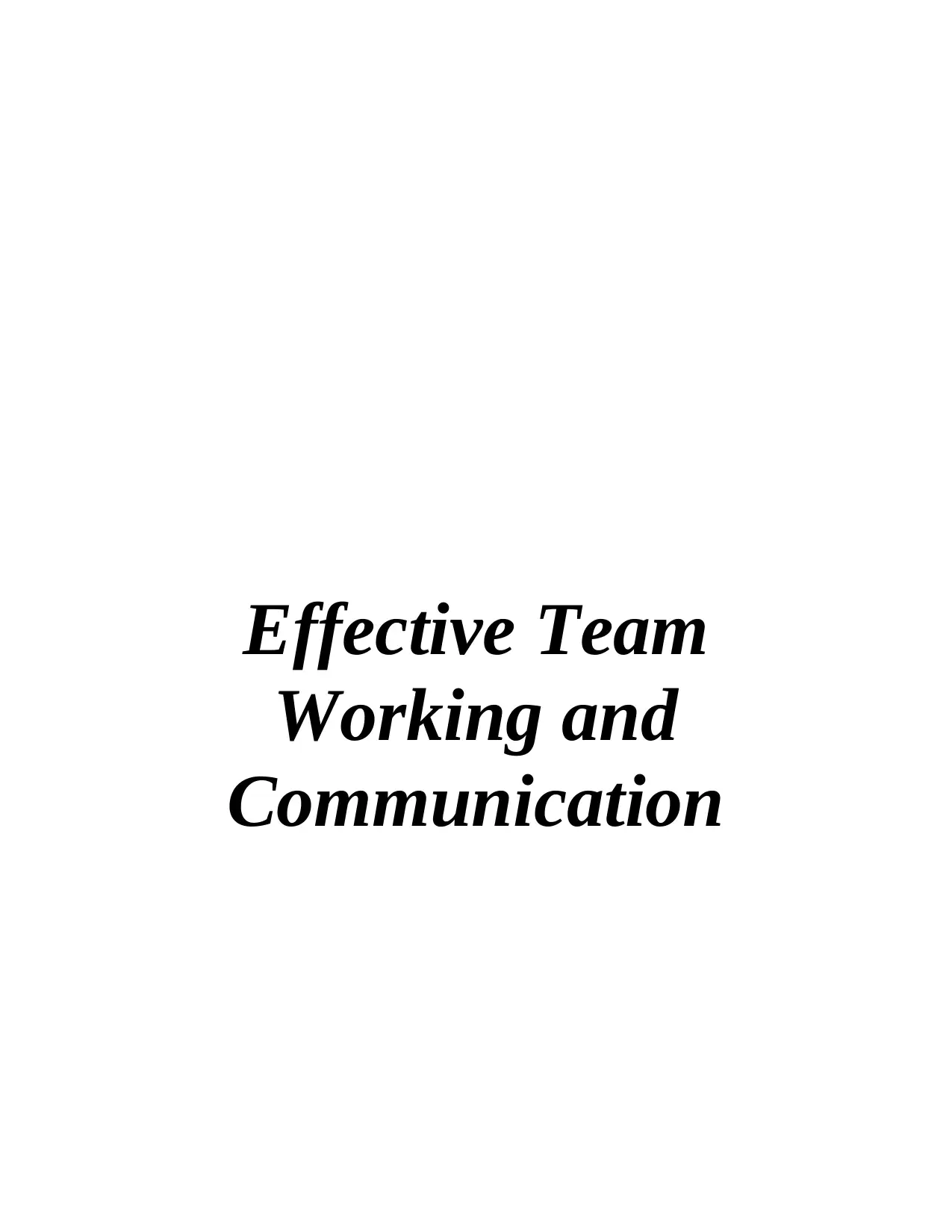
Effective Team
Working and
Communication
Working and
Communication
Secure Best Marks with AI Grader
Need help grading? Try our AI Grader for instant feedback on your assignments.
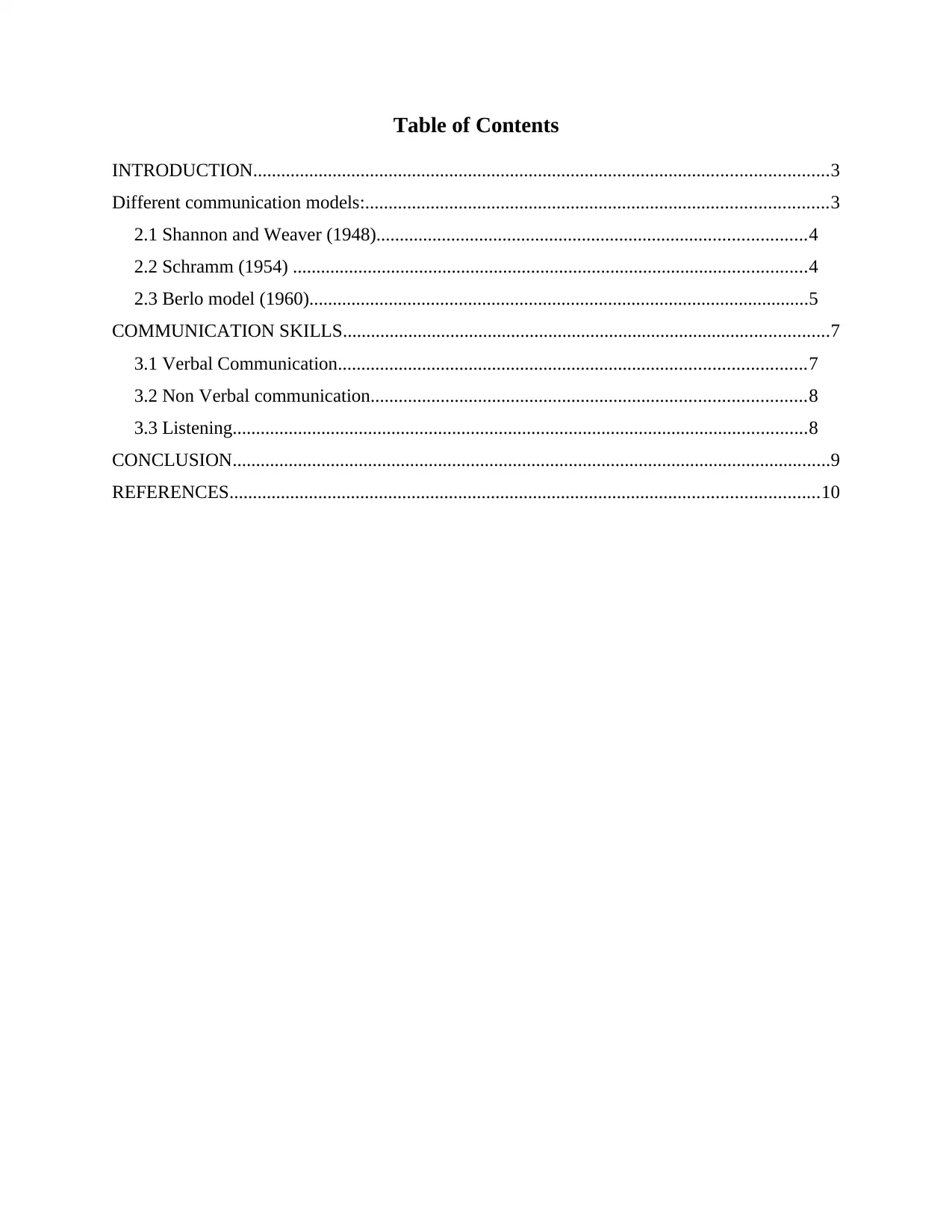
Table of Contents
INTRODUCTION...........................................................................................................................3
Different communication models:...................................................................................................3
2.1 Shannon and Weaver (1948)............................................................................................4
2.2 Schramm (1954) ..............................................................................................................4
2.3 Berlo model (1960)...........................................................................................................5
COMMUNICATION SKILLS........................................................................................................7
3.1 Verbal Communication....................................................................................................7
3.2 Non Verbal communication.............................................................................................8
3.3 Listening...........................................................................................................................8
CONCLUSION................................................................................................................................9
REFERENCES..............................................................................................................................10
INTRODUCTION...........................................................................................................................3
Different communication models:...................................................................................................3
2.1 Shannon and Weaver (1948)............................................................................................4
2.2 Schramm (1954) ..............................................................................................................4
2.3 Berlo model (1960)...........................................................................................................5
COMMUNICATION SKILLS........................................................................................................7
3.1 Verbal Communication....................................................................................................7
3.2 Non Verbal communication.............................................................................................8
3.3 Listening...........................................................................................................................8
CONCLUSION................................................................................................................................9
REFERENCES..............................................................................................................................10
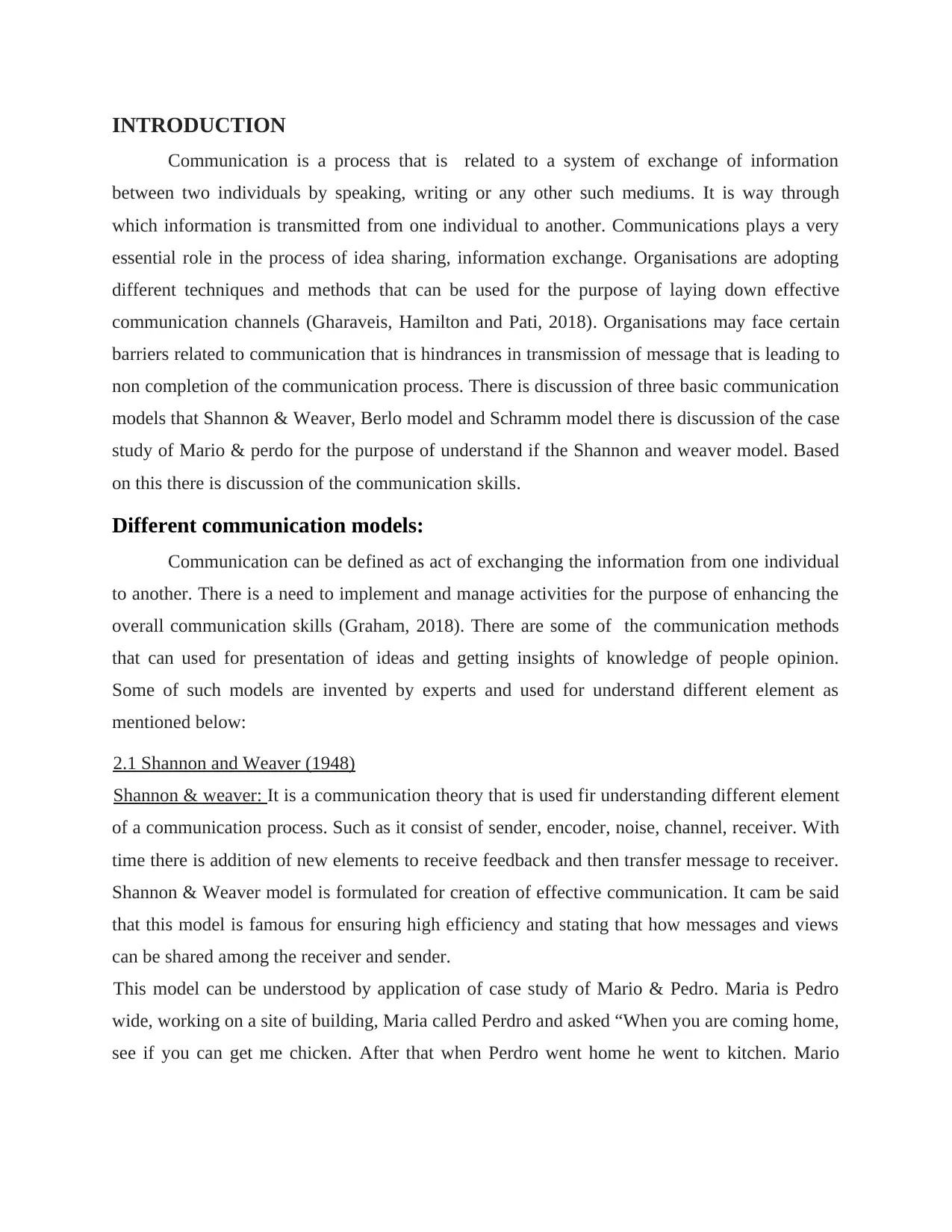
INTRODUCTION
Communication is a process that is related to a system of exchange of information
between two individuals by speaking, writing or any other such mediums. It is way through
which information is transmitted from one individual to another. Communications plays a very
essential role in the process of idea sharing, information exchange. Organisations are adopting
different techniques and methods that can be used for the purpose of laying down effective
communication channels (Gharaveis, Hamilton and Pati, 2018). Organisations may face certain
barriers related to communication that is hindrances in transmission of message that is leading to
non completion of the communication process. There is discussion of three basic communication
models that Shannon & Weaver, Berlo model and Schramm model there is discussion of the case
study of Mario & perdo for the purpose of understand if the Shannon and weaver model. Based
on this there is discussion of the communication skills.
Different communication models:
Communication can be defined as act of exchanging the information from one individual
to another. There is a need to implement and manage activities for the purpose of enhancing the
overall communication skills (Graham, 2018). There are some of the communication methods
that can used for presentation of ideas and getting insights of knowledge of people opinion.
Some of such models are invented by experts and used for understand different element as
mentioned below:
2.1 Shannon and Weaver (1948)
Shannon & weaver: It is a communication theory that is used fir understanding different element
of a communication process. Such as it consist of sender, encoder, noise, channel, receiver. With
time there is addition of new elements to receive feedback and then transfer message to receiver.
Shannon & Weaver model is formulated for creation of effective communication. It cam be said
that this model is famous for ensuring high efficiency and stating that how messages and views
can be shared among the receiver and sender.
This model can be understood by application of case study of Mario & Pedro. Maria is Pedro
wide, working on a site of building, Maria called Perdro and asked “When you are coming home,
see if you can get me chicken. After that when Perdro went home he went to kitchen. Mario
Communication is a process that is related to a system of exchange of information
between two individuals by speaking, writing or any other such mediums. It is way through
which information is transmitted from one individual to another. Communications plays a very
essential role in the process of idea sharing, information exchange. Organisations are adopting
different techniques and methods that can be used for the purpose of laying down effective
communication channels (Gharaveis, Hamilton and Pati, 2018). Organisations may face certain
barriers related to communication that is hindrances in transmission of message that is leading to
non completion of the communication process. There is discussion of three basic communication
models that Shannon & Weaver, Berlo model and Schramm model there is discussion of the case
study of Mario & perdo for the purpose of understand if the Shannon and weaver model. Based
on this there is discussion of the communication skills.
Different communication models:
Communication can be defined as act of exchanging the information from one individual
to another. There is a need to implement and manage activities for the purpose of enhancing the
overall communication skills (Graham, 2018). There are some of the communication methods
that can used for presentation of ideas and getting insights of knowledge of people opinion.
Some of such models are invented by experts and used for understand different element as
mentioned below:
2.1 Shannon and Weaver (1948)
Shannon & weaver: It is a communication theory that is used fir understanding different element
of a communication process. Such as it consist of sender, encoder, noise, channel, receiver. With
time there is addition of new elements to receive feedback and then transfer message to receiver.
Shannon & Weaver model is formulated for creation of effective communication. It cam be said
that this model is famous for ensuring high efficiency and stating that how messages and views
can be shared among the receiver and sender.
This model can be understood by application of case study of Mario & Pedro. Maria is Pedro
wide, working on a site of building, Maria called Perdro and asked “When you are coming home,
see if you can get me chicken. After that when Perdro went home he went to kitchen. Mario
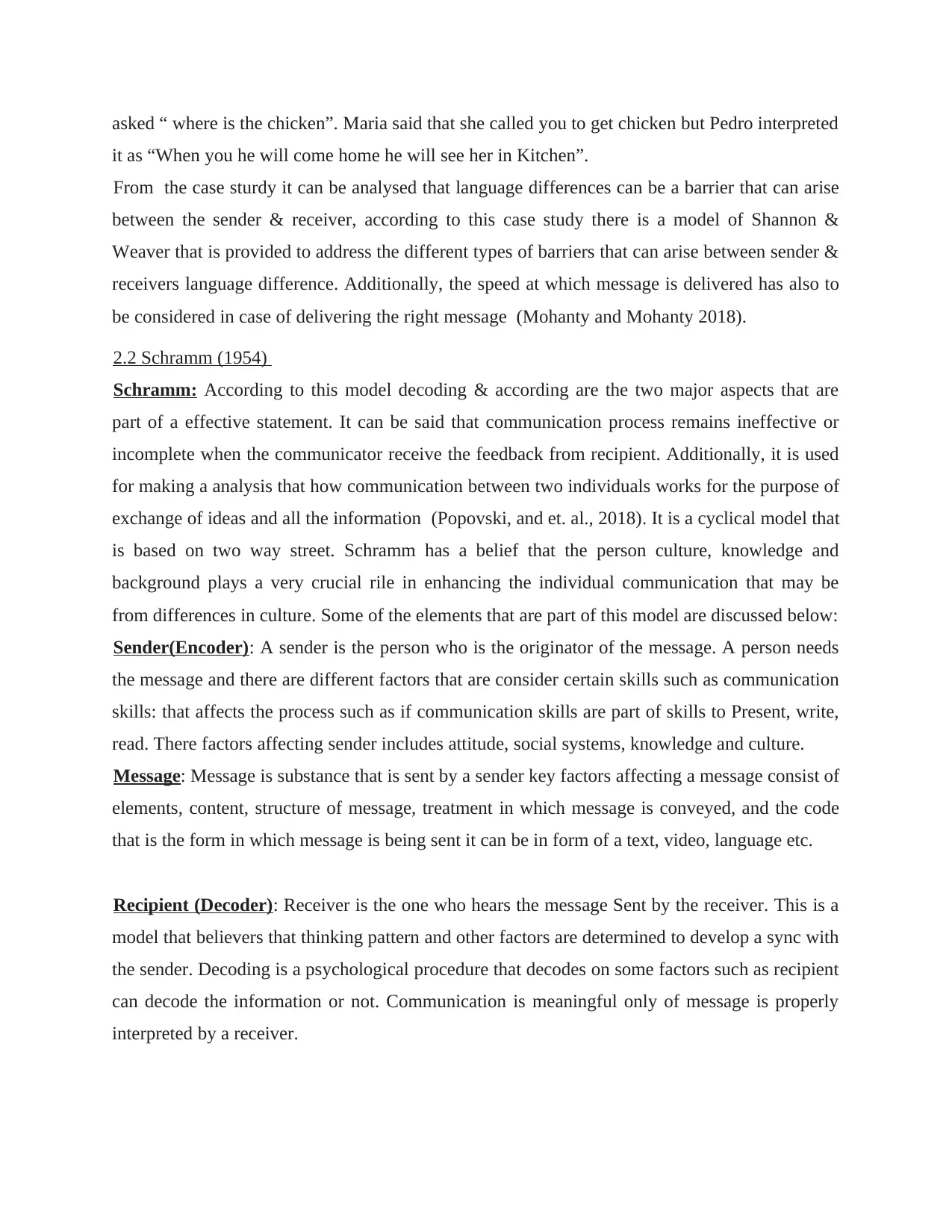
asked “ where is the chicken”. Maria said that she called you to get chicken but Pedro interpreted
it as “When you he will come home he will see her in Kitchen”.
From the case sturdy it can be analysed that language differences can be a barrier that can arise
between the sender & receiver, according to this case study there is a model of Shannon &
Weaver that is provided to address the different types of barriers that can arise between sender &
receivers language difference. Additionally, the speed at which message is delivered has also to
be considered in case of delivering the right message (Mohanty and Mohanty 2018).
2.2 Schramm (1954)
Schramm: According to this model decoding & according are the two major aspects that are
part of a effective statement. It can be said that communication process remains ineffective or
incomplete when the communicator receive the feedback from recipient. Additionally, it is used
for making a analysis that how communication between two individuals works for the purpose of
exchange of ideas and all the information (Popovski, and et. al., 2018). It is a cyclical model that
is based on two way street. Schramm has a belief that the person culture, knowledge and
background plays a very crucial rile in enhancing the individual communication that may be
from differences in culture. Some of the elements that are part of this model are discussed below:
Sender(Encoder): A sender is the person who is the originator of the message. A person needs
the message and there are different factors that are consider certain skills such as communication
skills: that affects the process such as if communication skills are part of skills to Present, write,
read. There factors affecting sender includes attitude, social systems, knowledge and culture.
Message: Message is substance that is sent by a sender key factors affecting a message consist of
elements, content, structure of message, treatment in which message is conveyed, and the code
that is the form in which message is being sent it can be in form of a text, video, language etc.
Recipient (Decoder): Receiver is the one who hears the message Sent by the receiver. This is a
model that believers that thinking pattern and other factors are determined to develop a sync with
the sender. Decoding is a psychological procedure that decodes on some factors such as recipient
can decode the information or not. Communication is meaningful only of message is properly
interpreted by a receiver.
it as “When you he will come home he will see her in Kitchen”.
From the case sturdy it can be analysed that language differences can be a barrier that can arise
between the sender & receiver, according to this case study there is a model of Shannon &
Weaver that is provided to address the different types of barriers that can arise between sender &
receivers language difference. Additionally, the speed at which message is delivered has also to
be considered in case of delivering the right message (Mohanty and Mohanty 2018).
2.2 Schramm (1954)
Schramm: According to this model decoding & according are the two major aspects that are
part of a effective statement. It can be said that communication process remains ineffective or
incomplete when the communicator receive the feedback from recipient. Additionally, it is used
for making a analysis that how communication between two individuals works for the purpose of
exchange of ideas and all the information (Popovski, and et. al., 2018). It is a cyclical model that
is based on two way street. Schramm has a belief that the person culture, knowledge and
background plays a very crucial rile in enhancing the individual communication that may be
from differences in culture. Some of the elements that are part of this model are discussed below:
Sender(Encoder): A sender is the person who is the originator of the message. A person needs
the message and there are different factors that are consider certain skills such as communication
skills: that affects the process such as if communication skills are part of skills to Present, write,
read. There factors affecting sender includes attitude, social systems, knowledge and culture.
Message: Message is substance that is sent by a sender key factors affecting a message consist of
elements, content, structure of message, treatment in which message is conveyed, and the code
that is the form in which message is being sent it can be in form of a text, video, language etc.
Recipient (Decoder): Receiver is the one who hears the message Sent by the receiver. This is a
model that believers that thinking pattern and other factors are determined to develop a sync with
the sender. Decoding is a psychological procedure that decodes on some factors such as recipient
can decode the information or not. Communication is meaningful only of message is properly
interpreted by a receiver.
Secure Best Marks with AI Grader
Need help grading? Try our AI Grader for instant feedback on your assignments.
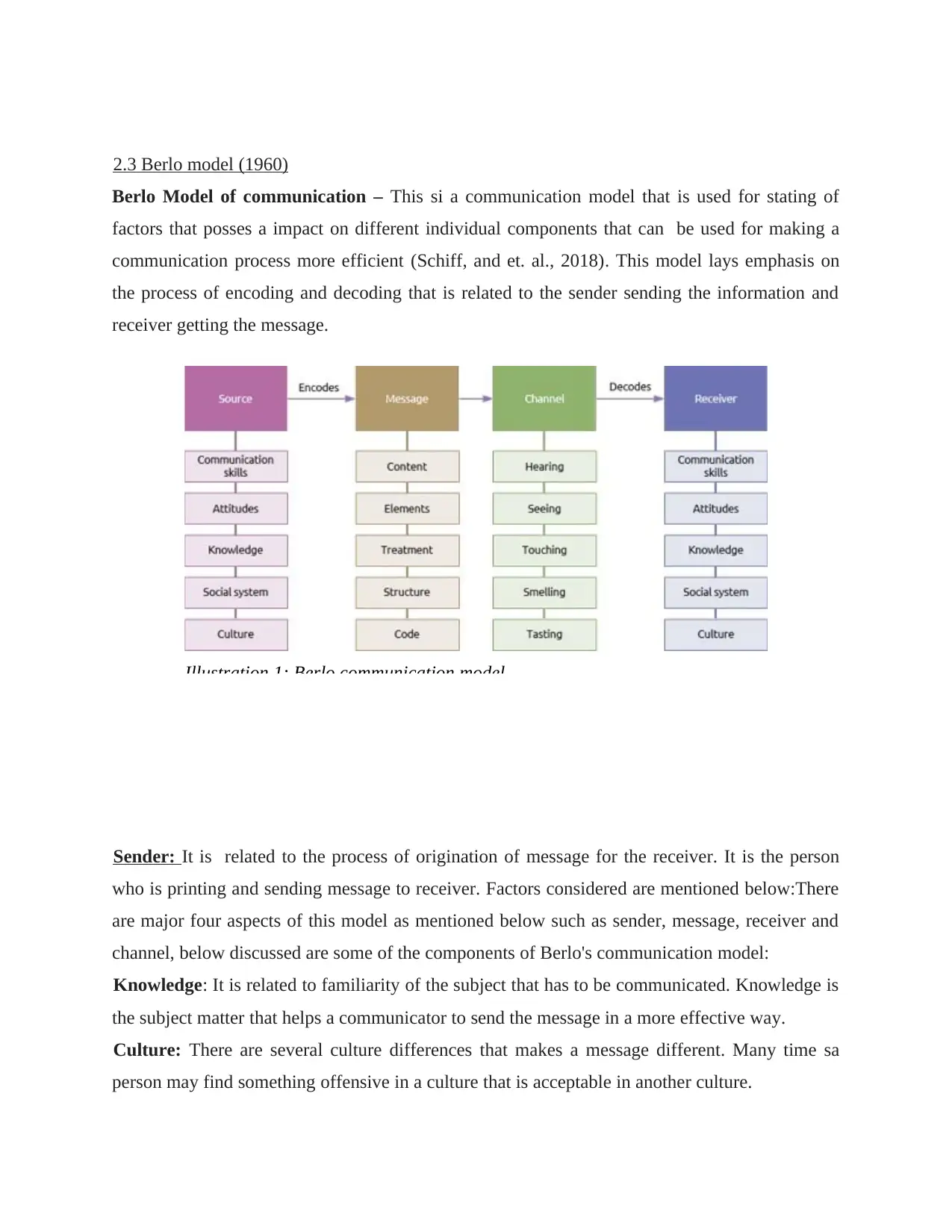
2.3 Berlo model (1960)
Berlo Model of communication – This si a communication model that is used for stating of
factors that posses a impact on different individual components that can be used for making a
communication process more efficient (Schiff, and et. al., 2018). This model lays emphasis on
the process of encoding and decoding that is related to the sender sending the information and
receiver getting the message.
Sender: It is related to the process of origination of message for the receiver. It is the person
who is printing and sending message to receiver. Factors considered are mentioned below:There
are major four aspects of this model as mentioned below such as sender, message, receiver and
channel, below discussed are some of the components of Berlo's communication model:
Knowledge: It is related to familiarity of the subject that has to be communicated. Knowledge is
the subject matter that helps a communicator to send the message in a more effective way.
Culture: There are several culture differences that makes a message different. Many time sa
person may find something offensive in a culture that is acceptable in another culture.
Illustration 1: Berlo communication model
Berlo Model of communication – This si a communication model that is used for stating of
factors that posses a impact on different individual components that can be used for making a
communication process more efficient (Schiff, and et. al., 2018). This model lays emphasis on
the process of encoding and decoding that is related to the sender sending the information and
receiver getting the message.
Sender: It is related to the process of origination of message for the receiver. It is the person
who is printing and sending message to receiver. Factors considered are mentioned below:There
are major four aspects of this model as mentioned below such as sender, message, receiver and
channel, below discussed are some of the components of Berlo's communication model:
Knowledge: It is related to familiarity of the subject that has to be communicated. Knowledge is
the subject matter that helps a communicator to send the message in a more effective way.
Culture: There are several culture differences that makes a message different. Many time sa
person may find something offensive in a culture that is acceptable in another culture.
Illustration 1: Berlo communication model
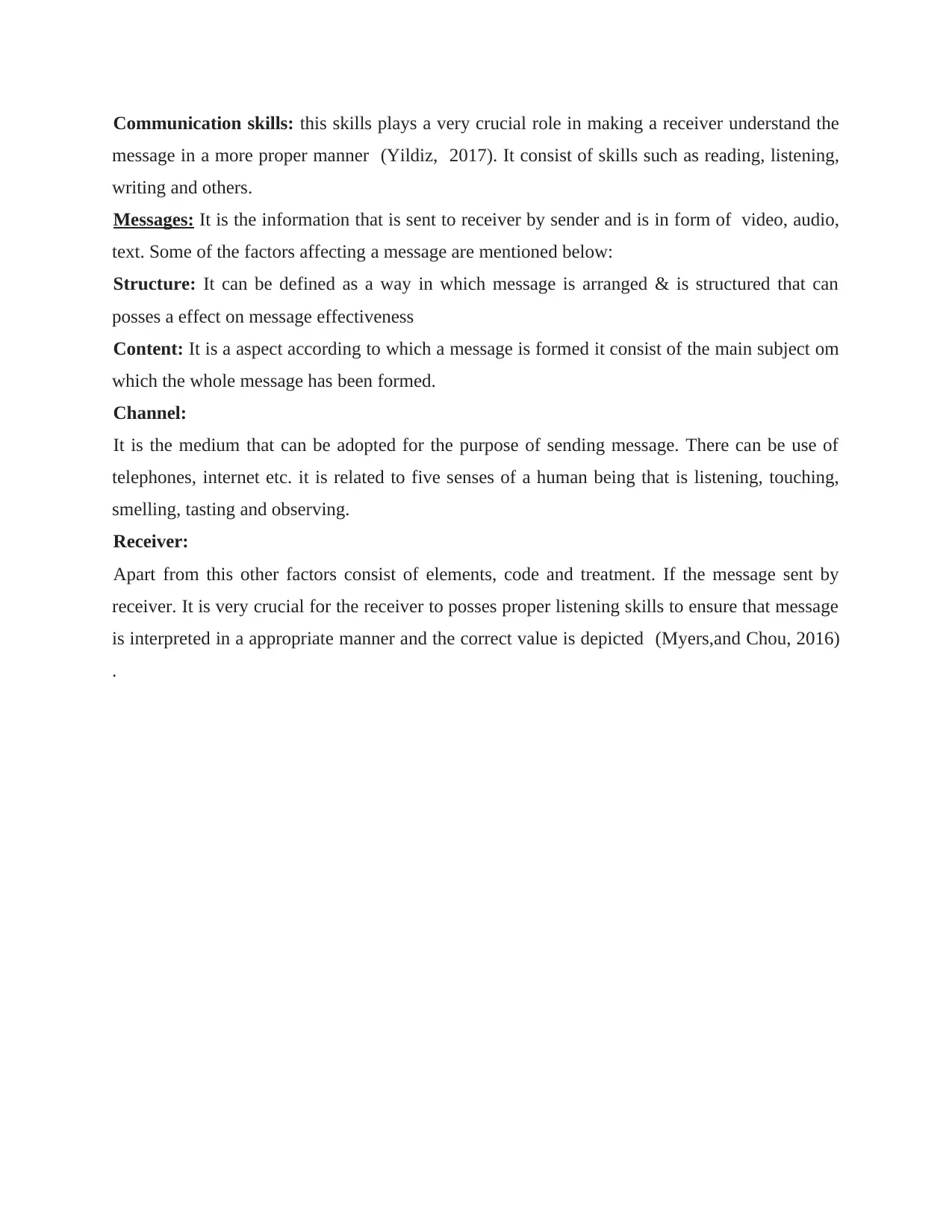
Communication skills: this skills plays a very crucial role in making a receiver understand the
message in a more proper manner (Yildiz, 2017). It consist of skills such as reading, listening,
writing and others.
Messages: It is the information that is sent to receiver by sender and is in form of video, audio,
text. Some of the factors affecting a message are mentioned below:
Structure: It can be defined as a way in which message is arranged & is structured that can
posses a effect on message effectiveness
Content: It is a aspect according to which a message is formed it consist of the main subject om
which the whole message has been formed.
Channel:
It is the medium that can be adopted for the purpose of sending message. There can be use of
telephones, internet etc. it is related to five senses of a human being that is listening, touching,
smelling, tasting and observing.
Receiver:
Apart from this other factors consist of elements, code and treatment. If the message sent by
receiver. It is very crucial for the receiver to posses proper listening skills to ensure that message
is interpreted in a appropriate manner and the correct value is depicted (Myers,and Chou, 2016)
.
message in a more proper manner (Yildiz, 2017). It consist of skills such as reading, listening,
writing and others.
Messages: It is the information that is sent to receiver by sender and is in form of video, audio,
text. Some of the factors affecting a message are mentioned below:
Structure: It can be defined as a way in which message is arranged & is structured that can
posses a effect on message effectiveness
Content: It is a aspect according to which a message is formed it consist of the main subject om
which the whole message has been formed.
Channel:
It is the medium that can be adopted for the purpose of sending message. There can be use of
telephones, internet etc. it is related to five senses of a human being that is listening, touching,
smelling, tasting and observing.
Receiver:
Apart from this other factors consist of elements, code and treatment. If the message sent by
receiver. It is very crucial for the receiver to posses proper listening skills to ensure that message
is interpreted in a appropriate manner and the correct value is depicted (Myers,and Chou, 2016)
.
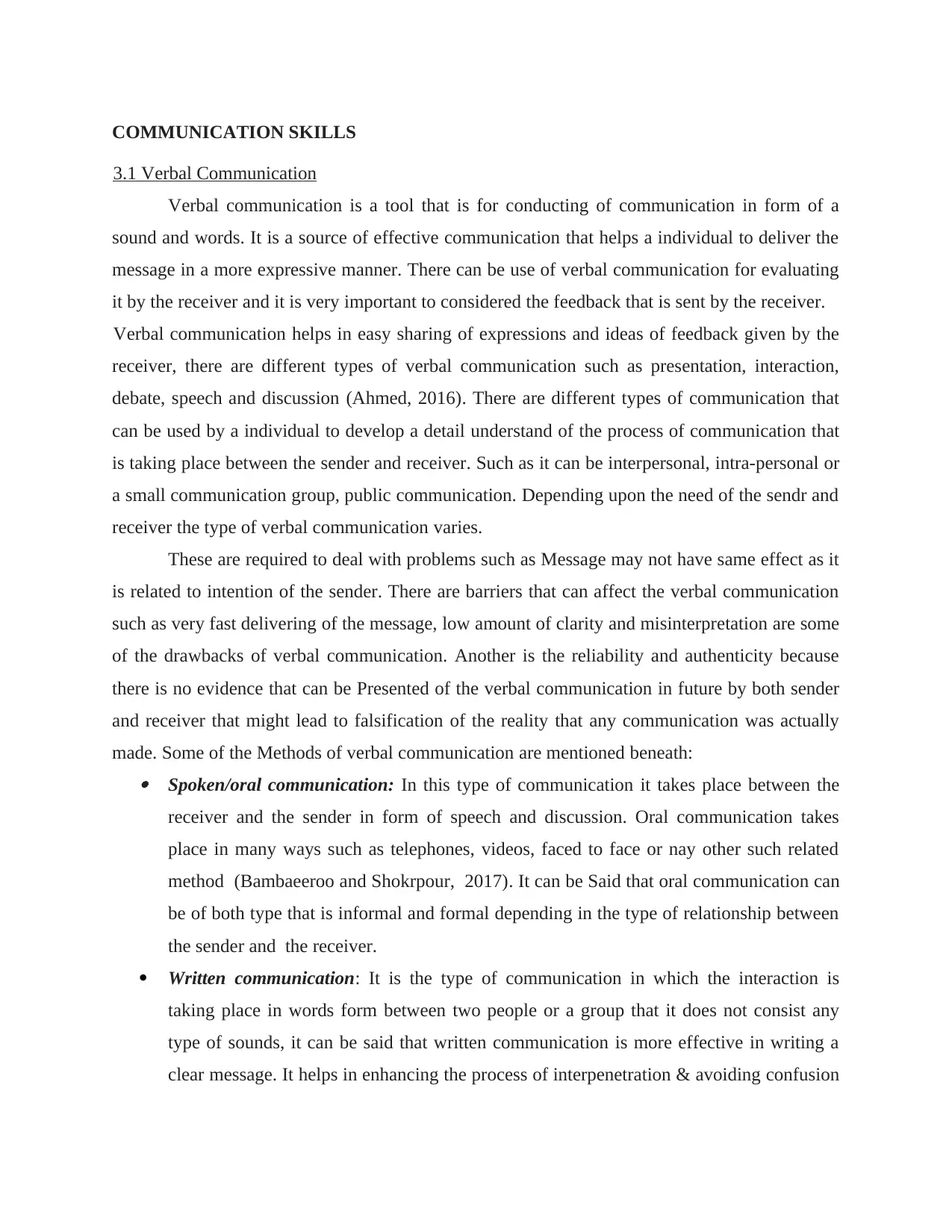
COMMUNICATION SKILLS
3.1 Verbal Communication
Verbal communication is a tool that is for conducting of communication in form of a
sound and words. It is a source of effective communication that helps a individual to deliver the
message in a more expressive manner. There can be use of verbal communication for evaluating
it by the receiver and it is very important to considered the feedback that is sent by the receiver.
Verbal communication helps in easy sharing of expressions and ideas of feedback given by the
receiver, there are different types of verbal communication such as presentation, interaction,
debate, speech and discussion (Ahmed, 2016). There are different types of communication that
can be used by a individual to develop a detail understand of the process of communication that
is taking place between the sender and receiver. Such as it can be interpersonal, intra-personal or
a small communication group, public communication. Depending upon the need of the sendr and
receiver the type of verbal communication varies.
These are required to deal with problems such as Message may not have same effect as it
is related to intention of the sender. There are barriers that can affect the verbal communication
such as very fast delivering of the message, low amount of clarity and misinterpretation are some
of the drawbacks of verbal communication. Another is the reliability and authenticity because
there is no evidence that can be Presented of the verbal communication in future by both sender
and receiver that might lead to falsification of the reality that any communication was actually
made. Some of the Methods of verbal communication are mentioned beneath: Spoken/oral communication: In this type of communication it takes place between the
receiver and the sender in form of speech and discussion. Oral communication takes
place in many ways such as telephones, videos, faced to face or nay other such related
method (Bambaeeroo and Shokrpour, 2017). It can be Said that oral communication can
be of both type that is informal and formal depending in the type of relationship between
the sender and the receiver.
Written communication: It is the type of communication in which the interaction is
taking place in words form between two people or a group that it does not consist any
type of sounds, it can be said that written communication is more effective in writing a
clear message. It helps in enhancing the process of interpenetration & avoiding confusion
3.1 Verbal Communication
Verbal communication is a tool that is for conducting of communication in form of a
sound and words. It is a source of effective communication that helps a individual to deliver the
message in a more expressive manner. There can be use of verbal communication for evaluating
it by the receiver and it is very important to considered the feedback that is sent by the receiver.
Verbal communication helps in easy sharing of expressions and ideas of feedback given by the
receiver, there are different types of verbal communication such as presentation, interaction,
debate, speech and discussion (Ahmed, 2016). There are different types of communication that
can be used by a individual to develop a detail understand of the process of communication that
is taking place between the sender and receiver. Such as it can be interpersonal, intra-personal or
a small communication group, public communication. Depending upon the need of the sendr and
receiver the type of verbal communication varies.
These are required to deal with problems such as Message may not have same effect as it
is related to intention of the sender. There are barriers that can affect the verbal communication
such as very fast delivering of the message, low amount of clarity and misinterpretation are some
of the drawbacks of verbal communication. Another is the reliability and authenticity because
there is no evidence that can be Presented of the verbal communication in future by both sender
and receiver that might lead to falsification of the reality that any communication was actually
made. Some of the Methods of verbal communication are mentioned beneath: Spoken/oral communication: In this type of communication it takes place between the
receiver and the sender in form of speech and discussion. Oral communication takes
place in many ways such as telephones, videos, faced to face or nay other such related
method (Bambaeeroo and Shokrpour, 2017). It can be Said that oral communication can
be of both type that is informal and formal depending in the type of relationship between
the sender and the receiver.
Written communication: It is the type of communication in which the interaction is
taking place in words form between two people or a group that it does not consist any
type of sounds, it can be said that written communication is more effective in writing a
clear message. It helps in enhancing the process of interpenetration & avoiding confusion
Paraphrase This Document
Need a fresh take? Get an instant paraphrase of this document with our AI Paraphraser
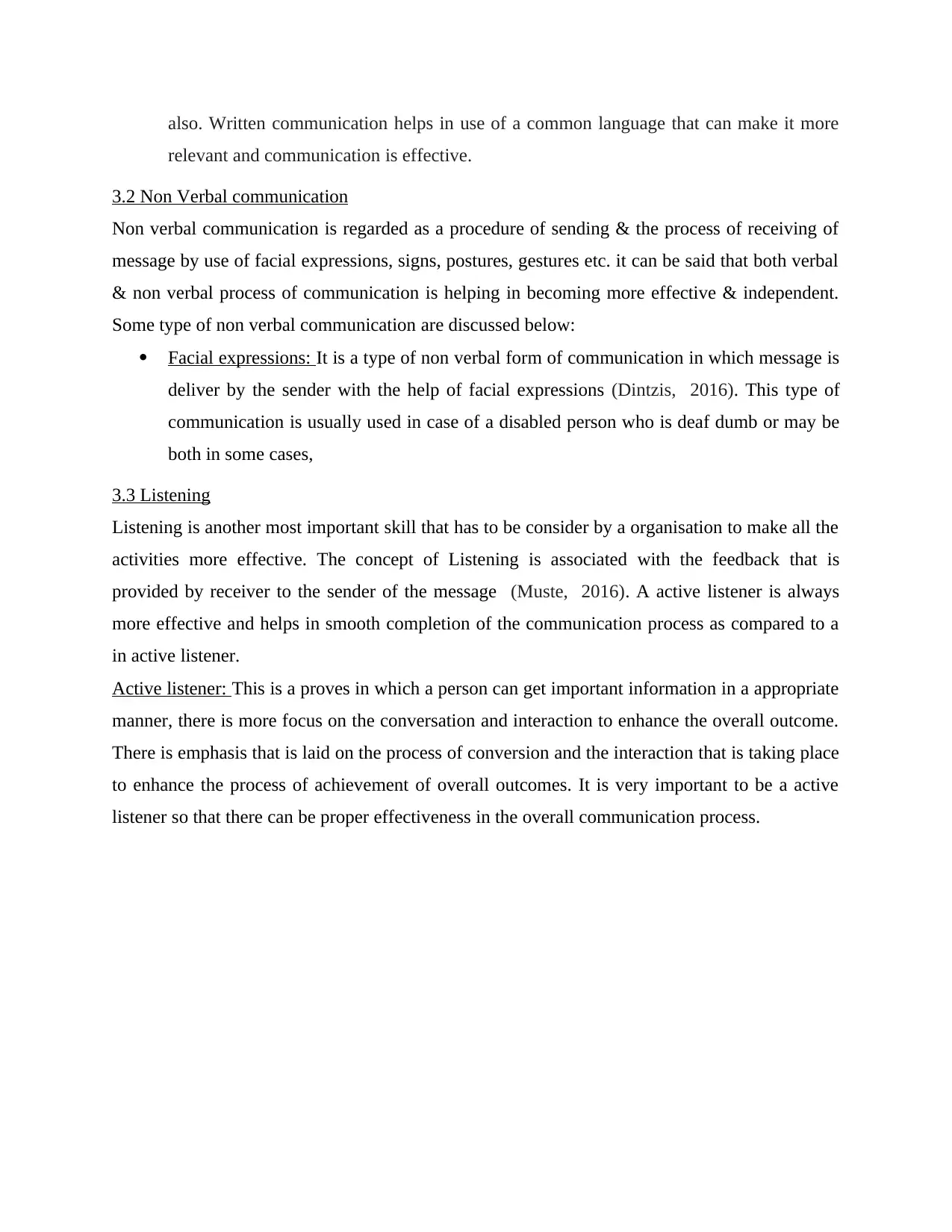
also. Written communication helps in use of a common language that can make it more
relevant and communication is effective.
3.2 Non Verbal communication
Non verbal communication is regarded as a procedure of sending & the process of receiving of
message by use of facial expressions, signs, postures, gestures etc. it can be said that both verbal
& non verbal process of communication is helping in becoming more effective & independent.
Some type of non verbal communication are discussed below:
Facial expressions: It is a type of non verbal form of communication in which message is
deliver by the sender with the help of facial expressions (Dintzis, 2016). This type of
communication is usually used in case of a disabled person who is deaf dumb or may be
both in some cases,
3.3 Listening
Listening is another most important skill that has to be consider by a organisation to make all the
activities more effective. The concept of Listening is associated with the feedback that is
provided by receiver to the sender of the message (Muste, 2016). A active listener is always
more effective and helps in smooth completion of the communication process as compared to a
in active listener.
Active listener: This is a proves in which a person can get important information in a appropriate
manner, there is more focus on the conversation and interaction to enhance the overall outcome.
There is emphasis that is laid on the process of conversion and the interaction that is taking place
to enhance the process of achievement of overall outcomes. It is very important to be a active
listener so that there can be proper effectiveness in the overall communication process.
relevant and communication is effective.
3.2 Non Verbal communication
Non verbal communication is regarded as a procedure of sending & the process of receiving of
message by use of facial expressions, signs, postures, gestures etc. it can be said that both verbal
& non verbal process of communication is helping in becoming more effective & independent.
Some type of non verbal communication are discussed below:
Facial expressions: It is a type of non verbal form of communication in which message is
deliver by the sender with the help of facial expressions (Dintzis, 2016). This type of
communication is usually used in case of a disabled person who is deaf dumb or may be
both in some cases,
3.3 Listening
Listening is another most important skill that has to be consider by a organisation to make all the
activities more effective. The concept of Listening is associated with the feedback that is
provided by receiver to the sender of the message (Muste, 2016). A active listener is always
more effective and helps in smooth completion of the communication process as compared to a
in active listener.
Active listener: This is a proves in which a person can get important information in a appropriate
manner, there is more focus on the conversation and interaction to enhance the overall outcome.
There is emphasis that is laid on the process of conversion and the interaction that is taking place
to enhance the process of achievement of overall outcomes. It is very important to be a active
listener so that there can be proper effectiveness in the overall communication process.
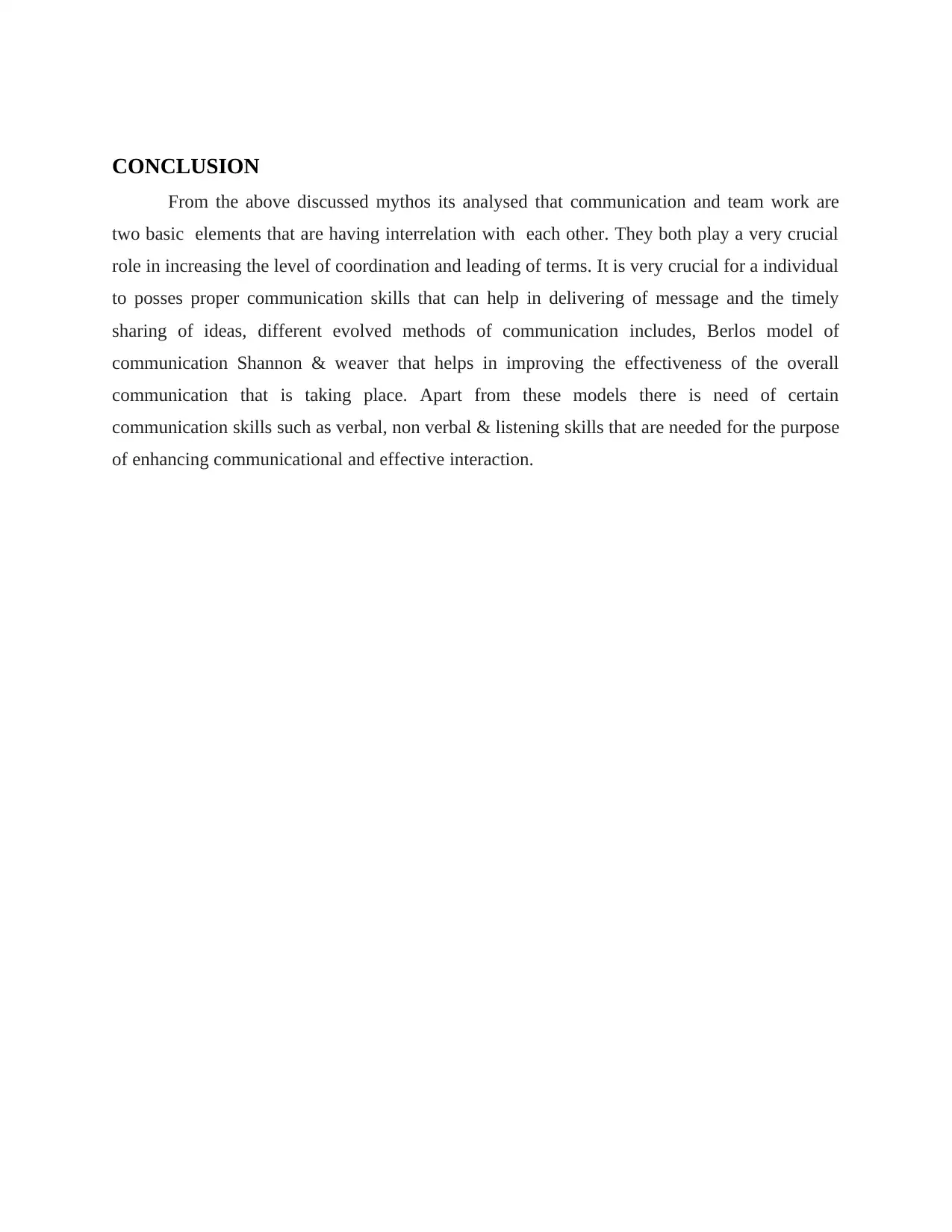
CONCLUSION
From the above discussed mythos its analysed that communication and team work are
two basic elements that are having interrelation with each other. They both play a very crucial
role in increasing the level of coordination and leading of terms. It is very crucial for a individual
to posses proper communication skills that can help in delivering of message and the timely
sharing of ideas, different evolved methods of communication includes, Berlos model of
communication Shannon & weaver that helps in improving the effectiveness of the overall
communication that is taking place. Apart from these models there is need of certain
communication skills such as verbal, non verbal & listening skills that are needed for the purpose
of enhancing communicational and effective interaction.
From the above discussed mythos its analysed that communication and team work are
two basic elements that are having interrelation with each other. They both play a very crucial
role in increasing the level of coordination and leading of terms. It is very crucial for a individual
to posses proper communication skills that can help in delivering of message and the timely
sharing of ideas, different evolved methods of communication includes, Berlos model of
communication Shannon & weaver that helps in improving the effectiveness of the overall
communication that is taking place. Apart from these models there is need of certain
communication skills such as verbal, non verbal & listening skills that are needed for the purpose
of enhancing communicational and effective interaction.
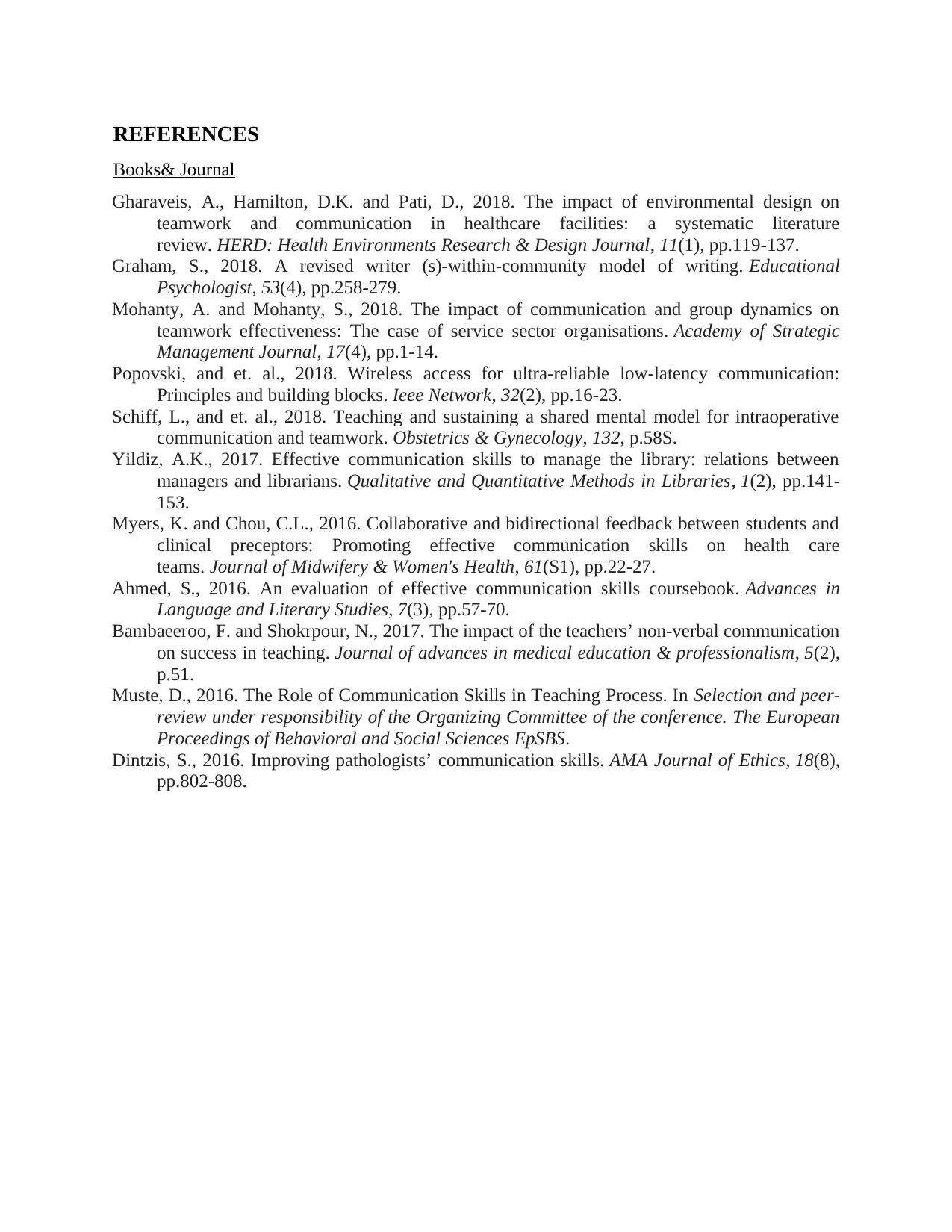
REFERENCES
Books& Journal
Gharaveis, A., Hamilton, D.K. and Pati, D., 2018. The impact of environmental design on
teamwork and communication in healthcare facilities: a systematic literature
review. HERD: Health Environments Research & Design Journal, 11(1), pp.119-137.
Graham, S., 2018. A revised writer (s)-within-community model of writing. Educational
Psychologist, 53(4), pp.258-279.
Mohanty, A. and Mohanty, S., 2018. The impact of communication and group dynamics on
teamwork effectiveness: The case of service sector organisations. Academy of Strategic
Management Journal, 17(4), pp.1-14.
Popovski, and et. al., 2018. Wireless access for ultra-reliable low-latency communication:
Principles and building blocks. Ieee Network, 32(2), pp.16-23.
Schiff, L., and et. al., 2018. Teaching and sustaining a shared mental model for intraoperative
communication and teamwork. Obstetrics & Gynecology, 132, p.58S.
Yildiz, A.K., 2017. Effective communication skills to manage the library: relations between
managers and librarians. Qualitative and Quantitative Methods in Libraries, 1(2), pp.141-
153.
Myers, K. and Chou, C.L., 2016. Collaborative and bidirectional feedback between students and
clinical preceptors: Promoting effective communication skills on health care
teams. Journal of Midwifery & Women's Health, 61(S1), pp.22-27.
Ahmed, S., 2016. An evaluation of effective communication skills coursebook. Advances in
Language and Literary Studies, 7(3), pp.57-70.
Bambaeeroo, F. and Shokrpour, N., 2017. The impact of the teachers’ non-verbal communication
on success in teaching. Journal of advances in medical education & professionalism, 5(2),
p.51.
Muste, D., 2016. The Role of Communication Skills in Teaching Process. In Selection and peer-
review under responsibility of the Organizing Committee of the conference. The European
Proceedings of Behavioral and Social Sciences EpSBS.
Dintzis, S., 2016. Improving pathologists’ communication skills. AMA Journal of Ethics, 18(8),
pp.802-808.
Books& Journal
Gharaveis, A., Hamilton, D.K. and Pati, D., 2018. The impact of environmental design on
teamwork and communication in healthcare facilities: a systematic literature
review. HERD: Health Environments Research & Design Journal, 11(1), pp.119-137.
Graham, S., 2018. A revised writer (s)-within-community model of writing. Educational
Psychologist, 53(4), pp.258-279.
Mohanty, A. and Mohanty, S., 2018. The impact of communication and group dynamics on
teamwork effectiveness: The case of service sector organisations. Academy of Strategic
Management Journal, 17(4), pp.1-14.
Popovski, and et. al., 2018. Wireless access for ultra-reliable low-latency communication:
Principles and building blocks. Ieee Network, 32(2), pp.16-23.
Schiff, L., and et. al., 2018. Teaching and sustaining a shared mental model for intraoperative
communication and teamwork. Obstetrics & Gynecology, 132, p.58S.
Yildiz, A.K., 2017. Effective communication skills to manage the library: relations between
managers and librarians. Qualitative and Quantitative Methods in Libraries, 1(2), pp.141-
153.
Myers, K. and Chou, C.L., 2016. Collaborative and bidirectional feedback between students and
clinical preceptors: Promoting effective communication skills on health care
teams. Journal of Midwifery & Women's Health, 61(S1), pp.22-27.
Ahmed, S., 2016. An evaluation of effective communication skills coursebook. Advances in
Language and Literary Studies, 7(3), pp.57-70.
Bambaeeroo, F. and Shokrpour, N., 2017. The impact of the teachers’ non-verbal communication
on success in teaching. Journal of advances in medical education & professionalism, 5(2),
p.51.
Muste, D., 2016. The Role of Communication Skills in Teaching Process. In Selection and peer-
review under responsibility of the Organizing Committee of the conference. The European
Proceedings of Behavioral and Social Sciences EpSBS.
Dintzis, S., 2016. Improving pathologists’ communication skills. AMA Journal of Ethics, 18(8),
pp.802-808.
1 out of 10
Related Documents
Your All-in-One AI-Powered Toolkit for Academic Success.
+13062052269
info@desklib.com
Available 24*7 on WhatsApp / Email
![[object Object]](/_next/static/media/star-bottom.7253800d.svg)
Unlock your academic potential
© 2024 | Zucol Services PVT LTD | All rights reserved.





